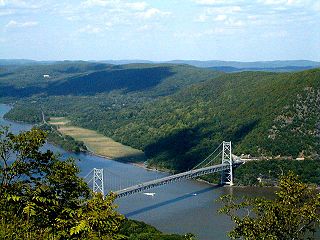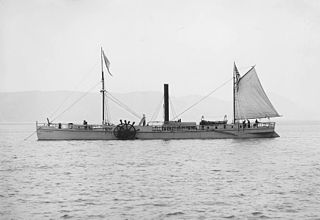Phoenix was a sidewheel steamboat built in 1807 by John Stevens and his son, Robert L. Stevens, at Hoboken, New Jersey.

A steamboat is a boat that is propelled primarily by steam power, typically driving propellers or paddlewheels. Steamboats sometimes use the prefix designation SS, S.S. or S/S or PS, however these designations are most often used for steamships.

Col. John Stevens, III was an American lawyer, engineer, and inventor who constructed the first U.S. steam locomotive, first steam-powered ferry, and first U.S. commercial ferry service from his estate in Hoboken. He was influential in the creation of U.S. patent law.

Colonel Robert Livingston Stevens was an American inventor and steamship builder who served as president of the Camden and Amboy Railroad in the 1830s and 1840s.
Phoenix measured 50 feet (15 m) long, 12 feet (3.7 m) wide and 7 feet (2.1 m) deep. She had 25 cabin berths and additional 12 berths in steerage.
Originally built to sail from New Brunswick, New Jersey, to New York City, Phoenix became the first steamboat to sail the open ocean, from New York to Philadelphia, in June 1809. The reason for this journey was that the restrictions placed on Stevens by the New York steamboat monopoly held by Robert Fulton and Robert Livingston meant that he could not operate profitably. Stevens decided to risk a journey over the open ocean so that he could operate on the Delaware River.

New Brunswick is a city in Middlesex County, New Jersey, United States, in the New York City metropolitan area. The city is the county seat of Middlesex County, and the home of Rutgers University. New Brunswick is on the Northeast Corridor rail line, 27 miles (43 km) southwest of Manhattan, on the southern bank of the Raritan River. As of 2016, New Brunswick had a Census-estimated population of 56,910, representing a 3.1% increase from the 55,181 people enumerated at the 2010 United States Census, which in turn had reflected an increase of 6,608 (+13.6%) from the 48,573 counted in the 2000 Census. Due to the concentration of medical facilities in the area, including Robert Wood Johnson University Hospital and Saint Peter's University Hospital, as well as Rutgers, The State University of New Jersey's Robert Wood Johnson Medical School, New Brunswick is known as both the Hub City and the Healthcare City. The corporate headquarters and production facilities of several global pharmaceutical companies are situated in the city, including Johnson & Johnson and Bristol-Myers Squibb.

The City of New York, usually called either New York City (NYC) or simply New York (NY), is the most populous city in the United States. With an estimated 2018 population of 8,398,748 distributed over a land area of about 302.6 square miles (784 km2), New York is also the most densely populated major city in the United States. Located at the southern tip of the state of New York, the city is the center of the New York metropolitan area, the largest metropolitan area in the world by urban landmass and one of the world's most populous megacities, with an estimated 19,979,477 people in its 2018 Metropolitan Statistical Area and 22,679,948 residents in its Combined Statistical Area. A global power city, New York City has been described as the cultural, financial, and media capital of the world, and exerts a significant impact upon commerce, entertainment, research, technology, education, politics, tourism, art, fashion, and sports. The city's fast pace has inspired the term New York minute. Home to the headquarters of the United Nations, New York is an important center for international diplomacy.

An ocean is a body of water that composes much of a planet's hydrosphere. On Earth, an ocean is one of the major conventional divisions of the World Ocean. These are, in descending order by area, the Pacific, Atlantic, Indian, Southern (Antarctic), and Arctic Oceans. The word "ocean" is often used interchangeably with "sea" in American English. Strictly speaking, a sea is a body of water partly or fully enclosed by land, though "the sea" refers also to the oceans.
The journey was hazardous, and a schooner accompanying Phoenix was driven off by a storm. Phoenix made harbor at Barnegat, New Jersey, and after waiting several days for the storm to subside, eventually sailed around New Jersey and up the Delaware River.
Following the journey, Phoenix made her first trip on the Delaware between Philadelphia and Trenton, on July 5, 1809.

Trenton is the capital city of the U.S. state of New Jersey and the county seat of Mercer County. It briefly served as the capital of the United States in 1784. The city's metropolitan area, consisting of Mercer County, is grouped with the New York Combined Statistical Area by the United States Census Bureau, but it directly borders the Philadelphia metropolitan area and was from 1990 until 2000 part of the Philadelphia Combined Statistical Area. As of the 2010 United States Census, Trenton had a population of 84,913, making it the state's tenth most populous municipality. The Census Bureau estimated that the city's population was 84,034 in 2014.











